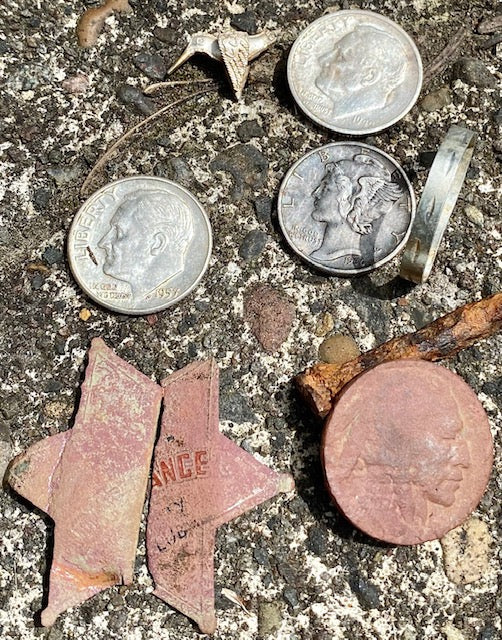
How to Avoid Digging Iron & Trash With The Minelab Equinox 800
This article is a study on how to avoid digging iron and trash with the Minelab Equinox 800.
After reading, please click this link to watch the YouTube Video that was created to accompany this blog article: LINK
The fear of missing out (‘FOMO’) can drive a metal detecting hobbyist to expend way too much energy digging trash. Don’t worry, this isn’t another article about metal detector discrimination -- I don’t use any. Let me tell you why.

Our detectors are always communicating to us, and it is the attempt to decipher the detectors language that drives us nuts. Many detectorists call this “the learning curve”. You must spend many hours using a machine in order to learn its language.
When hunting with the Equinox 800 in multi-frequency, the detector is reporting a vast amount of information about what’s in the ground.
This has reportedly caused many detectorists to be overwhelmed by noise.
Also, depending on how many tones you are using, multi-frequency tends to sweeten micro-trash target signals so that they sound more ‘whole’. It also makes deep iron nail falsing sound slightly more convincing.
Hunting in single frequency with the Equinox 800 however, will paint a different picture about what’s underneath your coil.
Problem 1: Why does my Equinox report low target ID numbers under 10 constantly when hunting in multi-frequency?
Explanation: Multi-frequency is so sensitive and precise that it is reporting very small fragments of tiny non-ferrous and ferrous objects in the ground, and it makes them sound like repeatable, good, low-or-high conducting targets. Many times, multi-frequency will just give out little blips that are not-repeatable but add to the amount of noise that you have to filter out while detecting.
Solution: Instead of using discrimination and notching out valuable targets, try switching over to a single frequency, say 10, 15, or 20kHz (5kHz tends to be too sensitive to EMI). If the target ID numbers and audio start radically breaking up, now you can be certain this is micro-trash.
Problem 2: Ok, so you’re hunting in a single frequency now because you don’t enjoy all of the micro-trash reported when hunting in multi-frequency. But the single frequency sometimes reports medium-to-small aluminum as deep signals with faint audio in the 20’s and 30’s -- like silver!
Explanation: Single frequencies don’t have enough information to paint the whole picture, yet they are quieter in sites with high EMI, and more stable in general because they aren’t reporting all the micro-trash. Does that mean that single frequencies aren’t as deep as multi-frequency? Absolutely not! If you watch our 12” and 14”- inch silver dime depth tests with the 11” and 15”- inch coils on the Equinox 800, single frequency beats multi-frequency in this test.
Solution: In order to avoid digging a deep hole for nothing but a tiny chunk of aluminum using single frequency, try switching over to multi-frequency when you need to cross-check your target. If the audio signal immediately reports as much louder, and the target ID numbers go from being in the 20’s and 30’s when in single frequency, down to 10 or below in multi-frequency, you can be more certain this is trash.
However, if you switch to multi-frequency and the audio signal is just slightly louder with a target ID of 10 or below, and the depth meter is showing some signals that it could be deeper, dig the plug and scan the plug and hole to see if it was surface trash and decide whether to dig further.
There are of course exceptions, where both single and multi-frequency will get fooled. But for the most part, you will save yourself a ton of hassle using these techniques.
In another example, if both multi-frequency and single frequency are loud, with single frequency reporting target ID’s in the 20’s & 30”s, and multi-frequency reporting target ID’s of around 10 or below, but the depth meter is showing deep, be very suspicious.
Problem 3: But won’t I miss gold rings when hunting in single frequency?
Explanation: Absolutely not, single frequency will report just as good if not better on gold jewelry depending on what frequency you’re using. In fact, if you’re in multi-frequency and getting overloaded with ground noise from micro-trash, you may be more likely to miss a gold target than when hunting in a quieter, more stable single frequency.
Solution: We know from question 1 that single frequencies will often break up or eliminate the audio and target ID of micro-trash. So when you run into a good non-ferrous target like a gold ring or a relic, you can be sure a single frequency will give you a very solid audio tone with a more consistent target ID.
There are of course cases where balled-up aluminum and can-slaw can fool you, but every detector is fooled by these.
As a side note: Bracelets and necklaces are different, they have a jumpy sound to them like some surface aluminum and bottle caps do, and they usually will not pin-point well. It is your choice whether to walk away from these types of target signals or not, but I have found many bracelets now by digging these strange signals.
Problem 4: I dig so much iron, nails, square nails, and chunks of farm equipment, how do I avoid this?
Explanation: There is no detector out there that won’t occasionally false on an iron nail or large iron object. If you’re a relic hunter you may even seek these signals out looking for large iron relics. But for the city and park detectorist, iron falsing can be infuriating to say the least.
Solutions:
Tip 1: Don’t discriminate your iron out, keep your iron audio on, don’t notch anything out, and keep iron bias at zero!
Use the setting on the Equinox 800 to turn your iron volume down so it doesn’t blow your ears out but you can still hear it in the background.
Tip 2: Next, examine your target. Does the non-ferrous signal have a clear repeatable nature with intermittent iron tones? That’s not bad, it just might need more examining before committing to dig.
For example, if the signal sounds amazing at first, but then begins to break up, and the target ID numbers go from stable to jumpy, you should have suspicions.
Tip 3: If your signal actually begins to feel like it’s moving from its original spot, definitely be suspicious.
Turn 90 degrees, circle the target, does the signal seem like it’s moving? Does the signal break up more? If so, that’s not good.
Tip 4: Here’s the kicker: after sweeping over the target 360 degrees, go back to your first position where the signal originally sounded best. If the detector is now reporting mostly iron tones and the signal is much more broken, this is almost certainly iron.
Tip 5: After sweeping over the same target for a while, pause for 10-15 seconds, keep the coil still on the ground directly over the target, if the signal sounds terrible when you go to begin sweeping over it again, there’s a good chance it’s iron.
Tip 6, Iron Halo’s: Iron halos tend to catch on your Equinox coils edge. So when examining your target, move the center of your coil so that it points directly over the spot where the right edge of the coil was and do a surgical sweep, and then move your coil back to sweeping over the center of the target.
Then move the center of your coil over the spot where the left edge of your coil was and do a tight sweep. Repeat this technique with the top and bottom edge of your coil as well.
When sweeping the center of your coil over the right, left, top, or bottom edge-spots, did you hear a very loud repeatable iron tone? This could very well mean that you are catching an iron halo.
Use the other tips in this section to do more detective work before deciding whether to dig or not.

Tip 7: If the detector is getting a repeatable signal on the edges of the iron halo:
Recently I was detecting in a bed of nails with the 15”-inch coil on the Equinox 800, something most detectorists would scoff at. But I love breaking and bending the rules and learning outside the box.
There was a big iron bolt in the ground, emanating a huge halo that was creating a nice silver-sounding false. Using tip number 6, I swept the center of my coil to the left and to the right and got a huge iron grunt. When I moved back over what I thought were two good targets 15” inches apart, and I turned 90 degrees, the signals either broke up or turned into iron grunting altogether. I continue to have no problem hunting in iron with a big coil. I go sloth-pace-slow, I multi-grid from different angles, and I investigate and isolate targets using the tips I describe here.
Tip 8: This tip can only be learned after hunting for a while. Iron false signals have very slightly different audio nuances than non-ferrous target signals.
Iron falses sometimes give off a signature “twang” sound, often going from loud to faint, or straight up abrupt and loud, despite the depth meter showing a deeper target.
Oftentimes these iron falses will drag out, only reporting one-way when sweeping.
Cross-check your target in two-tone, which gives more audio nuance information about targets. You will need to hunt in two-tone for a while to begin to learn this. 50-tone is reportedly good as well but takes a lot of patience and practice to learn. I recommend starting in five tone and two tone and cross-checking the two so that they become complimentary tools.
Tip 9: Let's say you find a good target while detecting in a single frequency, hitting in target ID range 20’s and 30’s, with the depth meter showing deep, but the signal sounds suspiciously loud. Then you switch over to multi-frequency and it also reports a deep target, but is audibly louder than it should be at that depth. But multi-frequency is reporting a target ID bouncing from the 20’s and 30’s down into the teens. Explore this target further, there’s a good chance it could be iron.
Tip 10: Deep non-ferrous targets will sometimes report intermittent iron grunts, so do not ignore those soft faint tones. Investigate. If the depth meter is showing very deep but the audio is louder, be very suspicious. If the depth meter coincides with what your audio is telling you, and you have investigated using the other tips mentioned above, then dig like a trained monkey!
It is important to remember that all of these tips are meant to be used together -- as a toolbox. Multi-frequency or single frequency aren’t bad or good, in fact I hope you have learned from reading this how they are tools that complement each other, and only when used together can they give you the best information about your target. The more tools you use, the more information you’ll gather to help you decide whether to dig or not.
Finally, every situation, every detecting site, will have different mineralization, trash, and iron content. Masking creates difficulties as well. These are only tips to use from my personal observations of many hours detecting and noticing consistencies in patterns. These tips are not meant to be taken as the ultimate truth, just tools to use for the never-ending learning curve.
Below are some graphs to help you begin to see how you could approach each target. Also keep in mind things like disappearing or drifting signals, one-way signals, and the other tips mentioned from this article.
Table 1

Table 2

Table 3

Table 4

Table 5


